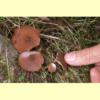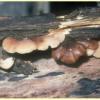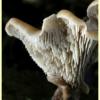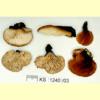
images/Lentinellus/Lentinellus.jpg
Small to large agaric, growing on the ground or on wood, with a white or cream to yellow spore print. Pileus brown, red or pink, rarely purple, not viscid. Lamellae adnate, sinuate or notched or decurrent, edges strongly serrate or unevenly torn. Stipe central, excentric, lateral, absent or apical (pseudostipe). Partial veil remnants absent. Spores hyaline or pale, amyloid, warty or spinose; germ pore absent. Cheilocystidia present. Lamellar trama regular or interwoven. Pileipellis a cutis or a trichoderm. Clamp connections present.
The combination of markedly serrate lamellae edges, rather tough and rubbery consistency of the fruit-bodies, and hyaline spores with amyloid ornamentation is very distinctive among gilled fungi. Species with no stipe can resemble
Crepidotus, but these have a rather soft texture and a brown spore print. The centrally stipitate species of
Lentinellus can resemble
Panus or
Lentinus because of their tough texture, but those genera have smooth, non-amyloid spores.
Lentinellus P.Karst., Bidrag Kännedom Finlands Natur Folk 32 [Ryssl. Hattsvamp. 1]: xviii, 246 (1879).
Three species: two with the stipe lateral or absent: Lentinellus castoreus and L. pulvinulus (= L. hepatotrichus as far as the type specimen, but not necessarily as far as all other interpretations by Australian authors) and one with a central to excentric stipe: L. tasmanicus (= L. omphalodes as used by Australian authors). The various other Northern Hemisphere names (such as L. cochleatus, L. flabelliformis, L. ursinus and L. vulpinus) that have been used for Australian material all seem to be have been incorrectly applied.
W.A., S.A., Qld, N.S.W., Vic. and Tas. (and probably also N.T.).
In native forests, sometimes in pine plantations.
On wood or on the ground.
Saprotrophic.
Bougher, N.L. (2009a),
Fungi of the Perth region and beyond: a self-managed field book, Western Australian Naturalists' Club (Inc.), Perth. [
Description and
Illustration of
L. pulvinulus]
Breitenbach, J. & Kränzlin, F. (eds) (1991), Fungi of Switzerland. Volume 3. Boletes and Agarics 1st part. Edition Mykologia, Lucerne. [Illustration, Description and Microcharacters of L. cochleatus, L. omphalodes and L. ursinus from Europe]
Fuhrer, B. (2005), A Field Guide to Australian Fungi. Bloomings Books, Hawthorn. [Description and Illustration of L. aff. omphalodes, L. pulvinulus and L. aff. ursinus]
Fuhrer, B. & Robinson, R. (1992), Rainforest Fungi of Tasmania and South-east Australia. CSIRO Press, East Melbourne. [Illustration of Lentinellus sp.]
Gates, G. & Ratkowsky, D. (2003), The fungal genus Lentinellus in Tasmania, Tasmanian Naturalist 125: 9–13. [Brief Description and Microcharacters of L. castoreus (as L. hepatotrichus), L. pulvinulus and L. tasmanicus (as L. omphalodes), along with Key]
McCann, I.R. (2003), Australian Fungi Illustrated. Macdown Productions, Vermont. [Illustration of L. hepatotrichus, and several unnamed species]
Petersen, R.H. & Hughes, K.W. (2004), A preliminary monograph of Lentinellus (Russulales), Biblioth. Mycol. 198: 1–268. [Illustration, Description and Microcharacters of L. castoreus, L. pulvinulus and L. tasmanicus]
Ratkowsky, D. & Gates, G. (2006), Lentinellus reconsidered, Tasmanian Naturalist 128: 8–10. [Discussion of correct names for the three species in Tasmania, and Key]
Segedin, B.P. (1996), A new species of Lentinellus (Hericiales, Lentinellaceae) and a revision of taxa attributable to Lentinellus in New Zealand, New Zealand J. Bot. 34: 249–261. [B&W Illustration, Description and Microcharacters of L. pulvinulus and L. ursinus, under which is included L. hepatotrichus]





